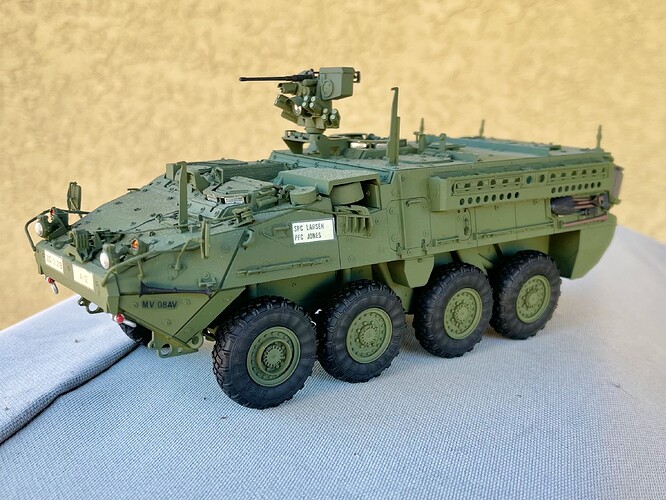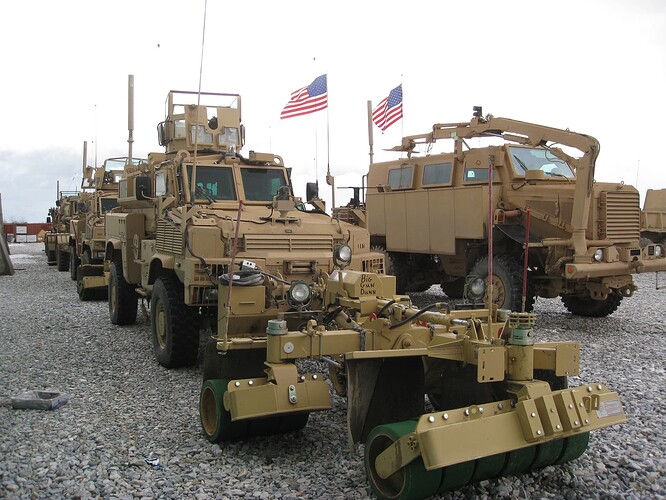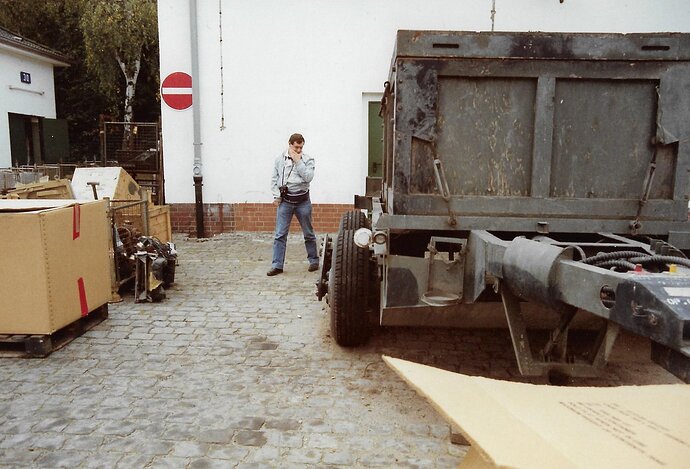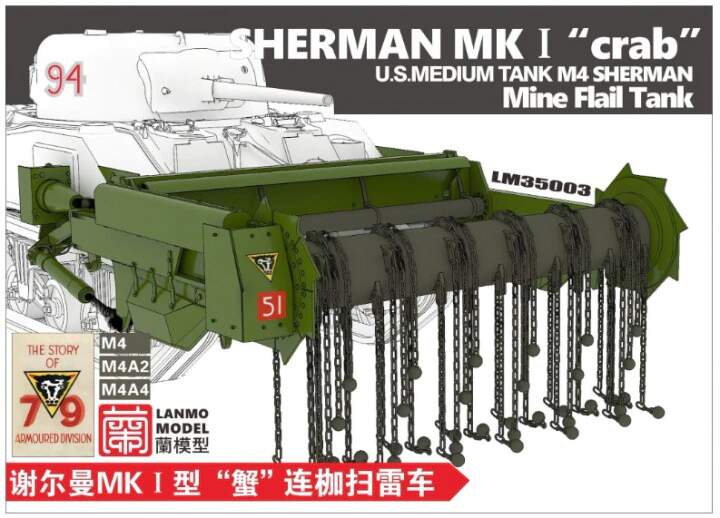Hello All,
I just wanted to see who is interested in talking about all things that are made to go boom or to defeat things that go boom. I’ll see what I can find in my treasure trove of pics and documents.
Agreed. There’s a variety of kits out there that could be used.
The wars in Iraq (2003-2010) and Afghanistan (2001-2023) brought the importance of counter-IED and route clearance to the forefront. The enemy’s usage of improvised explosive devices (IEDs) while not new, became widespread and necessitated field commanders to focus on these in order to keep MSRs clear for logistical convoys to safely move vital supplies to the troops in forward areas, as well as for combat troops to patrol safely through combat routes.
Previous generation but aligns with the theme…
Centurion AVRE (105) with Pearson plough (September 1991).
Very similar setup to the M58 MCLIC.
here being pulled by an M9 Armored Earthmover.

Attached to an M60 ABLV.

Towed behind a Ukrainian Army M113A3.
Over the last 22 years, the United States fielded a large number of vehicles and equipment packages for mine detection and clearance. Trying to figure out which vehicle served when in what configuration is really difficult. To my knowledge, no book on the subject exists. Books on mine warfare, in general, are few.
Many of the mine detection and destruction systems pioneered in World War II reappear in the pictures above. Ground penetrating scanning systems are fairly new.
One thing I find curious is the relationship between the cost of mines and cost to find and remove them. Mine clearing equipment always looks so elaborate and therefore expensive to build. Why is that so? How long do those vehicles and devices last in service? Why not push or drag simple trailers full of dirt instead of fielding those elaborate devices?
I find it very interesting that vehicles like the Husky strongly resemble German armored cars of World War II. Both have boat hulls as a counter measure for mines.
Mines are a terrible legacy of warfare. Ask anyone that has lost a limb or lost a family member while retaking farmland that was once a battlefield.
Places like Vietnam, Laos, Cambodia, Africa, etc…
Mines until recently, never had a disabling feature that would render them inert after hostilities end, so there are approximately millions of these mines lying in wait, decades after wars have ended.
Technology has evolved to find these silent killers from farmlands all over the world.
From the old metal chain flails of the Sherman “Crab” tank of WW2…
to the Husky Mk2 VMMD…
Mines do not discriminate between soldiers and civilians. Which means that militaries all over the world try to put forth the most advanced tech possible to find and remove them.
According to the articles I read last night, millions of uncleared mines currently remain in the ground, mostly spread across a dozen or so countries.
I find it surprising that no model company has yet released a plastic Sherman Flail. That seems like a subject that would sell very well.
The Takon Raumer S and Meng Vs.Kfz 617 are on my want list. AFV Club makes a Stryker with a mine plow that is new to me.

Yeah; the M1132 Engineer Squad Vehicle; AFV Club also sells the engineer blade as a separate kit. Good kit.
Blast Models also made a resin replica of the SPARK mine roller for the AFV Club M1126 Stryker.

The SPARK mine roller can also be fitter on Humvees, M-ATVs, LMTVs and other vehicles.
Legend makes several kits that are suited to different vehicles, from the Academy M1151 to the Kinetic Models RG-31.

The technology has changed immensely. In WWII, most mines were operated manually, you had to step on them, run them over, or activate a tripwire.
Then they added magnetic fuzing. The mine was set off by the magnetic field of a vehicle, you could step on it, drive over it, push a trailer of dirt over it, nothing would happen. But go over it with a strong magnetic field, like a tank, and boom!
Now they have a variety of different fuzing systems, including command detonation using cell phones and other devices, plus all of the older systems.
So it takes a lot to clear a minefield, or even a road.
Ken
Thank you for the information! Is the Stryker with the mine plow accurate? Can it be built out of the box with perhaps some minor corrections?
I’ve built the infantry version of the Stryker from AFV Club and I think out of this one and the Trumpeter version, the AFV Club is more accurate dimension-wise. Granted the AFV Club version is the older variant without the Double V hull, but you can get the DVH upgrade from Shapeways, which is what I did.


I’ve been reading about some of those detonation systems over the last few days. As a former computer programmer, I can think of many nasty mine detonation algorithms a smart mine could use to defeat mine clearing efforts. I presume people who actually work in the field have considered or implemented such things and far worse.
In some ways, autonomous combatants are an evolution of mines. They are essentially mines that can move, project their destructive potential a greater distance, and follow far more complex rules of engagement.
I read one interesting paper, dated from the early 2000s, about a sonic system for detecting and detonating mines. I wonder what happened to that.
That model looks lovely!
Last year, I purchased a Stryker variant by Trumpeter and was promptly informed that the AFV Club kits are significantly better. HAHA! Oh well.
Now that I know the AFV Club Styrker with mine plow exists, I will purchase that one.
I did a bit of rock-kicking and found that Lanmo Models makes a conversion kit to creat the Mk1 “Crab” tank; which is modeled after the "Crab’ Sherman at Bovington (picture posted a couple of posts above).
I can imagine using either aq Tasca/Asuka Sherman as a base for this.
A subject that is not so near and dear to my heart; driving around in circles for twelve hours waiting to have your multi-million dollar machine blown up by an EFP or something as simple as an 82mm mortar shell that cost $30 to rig and set to explode at the precise point of weakness.
Billions of dollars spent on technologies to defeat said explosives with no return on investment…
A fleet of worthless vehicles that that couldn’t be maintained by the soldiers using them, and completely unwanted by the military once the conflicts concluded…
An important subject of the 20 years of the American GWOT experience to be sure, but one I’d prefer not to model. In my last tour in Iraq, one company alone lost six M-2A3 Bradleys melted to the ground from simple IED’s. Thank God everyone escaped; a testament to the systems and training of the crews and infantrymen.
Pardon my passion here. I’m not trying to be political or to pass judgment on anyone else’s modeling interests, but this one hits a sore spot.
I totally understand your sentiment. In more ways than one. I lost a good friend to an IED in 2004 while leaving Mosul, leaving a wife and a 5-year old boy behind. There isn’t a day that goes by that I don’t think about the “What if…”.
I have an M1 Mine breacher vehicle from RFM and a Stryker ESV in the stash. Would love to tackle one of them. About 2 years ago I built a Dragon M1 Panther II mine clearing vehicle. Nice kit.
Well whatdaya know! That is a brand new company and they also sell M1A1 Dozer Blades for both HVSS and VVSS suspensions.
Edit: I just found an article on Armorama from a 10 days ago announcing the dozer blade. Guess I missed the memo again.
The flail conversion is about $45 US on eBay which includes shipping.























